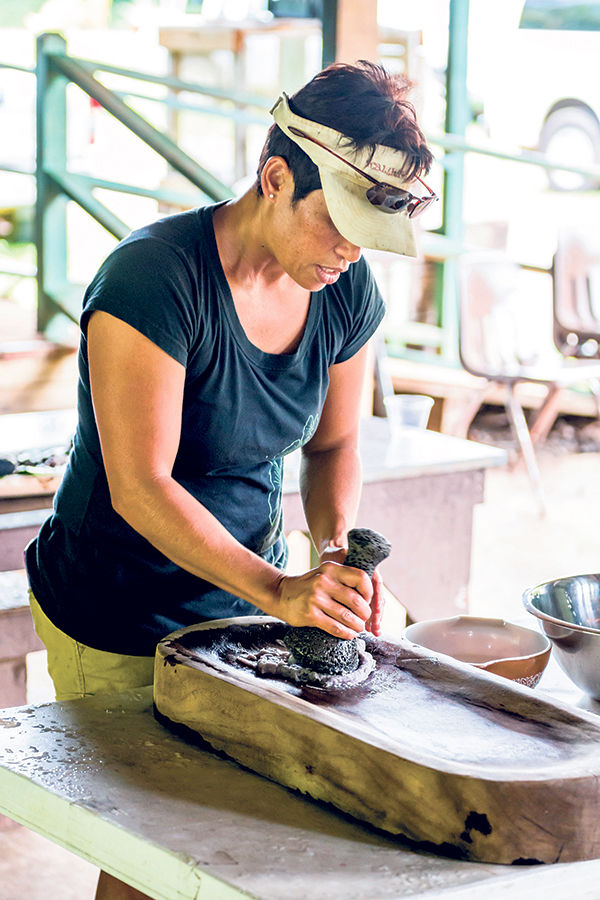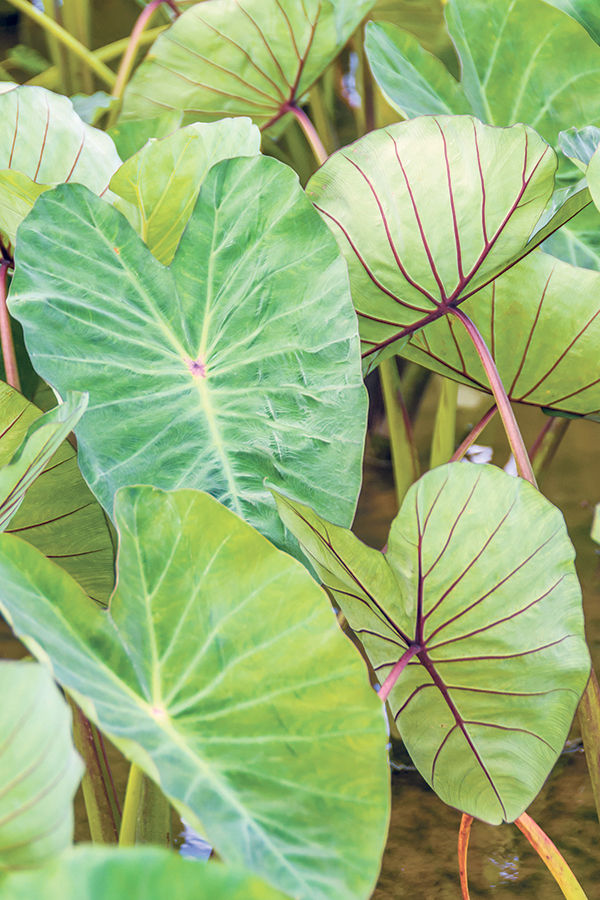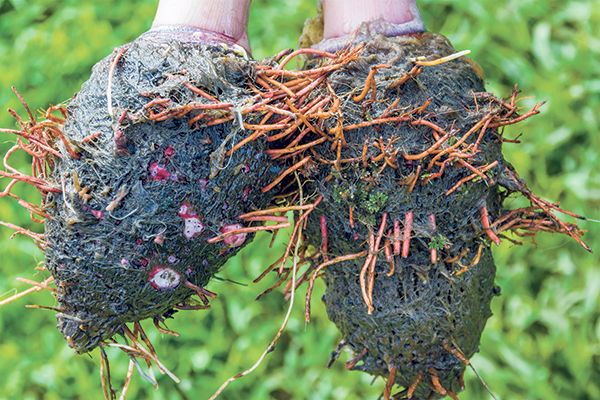Kalo is the Hawaiian word for taro and how it came to Hawaii is debatable. A popular theory is that kalo was among the canoe crops brought by Polynesian voyagers who first settled Hawaii. The book “Native Planters of Old Hawaii” considers the possibility of wild taro seeds being brought to Hawaii by birds. Either way, taro is mentioned in Chinese books as early as 100 B.C. and was thriving in Egypt at the beginning of the Christian era.
Kalo, which is considered Hawaii’s staff of life, is deeply rooted in cultural lore. Kane, the procreator of nature and man, buried his first-born near his house. From it sprang a taro plant, which Kane named Haloa naka, or “long stalk trembling (leaf).”
Native cultivation of kalo in Hawaii has produced hundreds of plants, which are adaptable to various growing conditions. Upland (dry land) kalo is planted in non-flooded, rain-fed areas, and lowland (wetland) kalo is grown in waterlogged or flooded fields called lʻoi kalo. Hawaiians often call the plant ohana and have 24 names for various parts of the plant.
Corms grow underground, much like a beet or carrot, and can be cooked like a potato. The flesh is typically purple and tastes mild and sweet. Leaves and stalks are usually steamed or boiled. Corms, leaves and stems must be cooked for long periods (about an hour) in adequate liquid, to leach out calcium oxalate. If undercooked, calcium oxalate crystals will leave a burning, itchy sensation in the mouth and throat. Although this is not fatal, it is highly uncomfortable.
Kalo grows year-round and is ready for harvest eight to 10 months after planting. Many Hawaiian families grow old varieties, but commercial farmers use hybrids developed by the University of Hawaii College of Tropical Agriculture and Human Resources. These hybrids produce large, moist corms that are ideal for making poi.
Leaves and stems
The heart-shaped leaf is called lau. Laulau is a traditional dish in which kalo leaves are folded around meat, fish or vegetables and steamed. When finished, the succulent leaves have mineral notes and taste similar to spinach. Luau is a boiled dish made with leaves, stems and coconut milk, to which diced onions are often added.
Corm
I buy cooked taro corms from Da Food Chain (see below), but they are easy enough to make at home. Simply place them in boiling water and cook at a simmer for about one hour. The corms are done when a cake tester easily pierces them. When cool, remove the bark-like skin. You can dice and sauté with garlic, chili peppers, green onions and herbs; slice thinly and make a gratin; shred for “hash browns” or add cubes to soups and stews.
Pakiai
Pakiai, pronounced “pa key aye,” means to break up cooked taro with a pounder in the first stage of poi making. The result, which is also called pakiai, is a thick, sticky paste. It hardens when refrigerated and can be cut into slabs, fried and topped with vegetables, Spam and eggs. When cubed and fried, the centers fill with air, which make unique and super crunchy croutons.
Poi
Water is added to pakiai to make poi. Many visitors think poi is a party trick they have to endure during their first luau. Unaccustomed to the texture, they try it so they can check an item off their “Things to do in Hawaii” bucket list. Luau poi is not the best place to start, as it is often watered down and stretched with additives. Freshly made poi is sweet, but after it sits for a day or so, it begins to ferment, bubble and taste sour. Old-timers like this poi best. Poi is eaten with salty dishes such as kalua pork and lomilomi salmon. Try using it in soups, stews or shakes as a thickener.
Kalo can be found at:
You can watch Punohu Kekaualua pakiai in the traditional manner on Wednesday afternoons, during the Kauai Culinary Market at The Shops at Kukuiula. Fresh poi and raw corms from the Haraguchi family are available at the Hanalei Taro & Juice Co.
If you live on the Eastside or in the Lihue area, you can order poi and cooked taro corms from www.DaFoodChain.com. They will deliver it to your home every Friday.
Kalo Festival today
Today, from 11 a.m. until 5 p.m., the Waipa Foundation is hosting its 5th annual Kalo Festival. There is live music, food vendors, a largest kalo contest as well as a recipe contest. Lee Anne Wong, one of the last four contestants on the first season of Bravo’s reality show “Top Chef,” owner of Koko Head Cafe in Honolulu and author of “Dumplings All Day Wong,” will make kalo dumplings during a demonstration. For more information, visit www.WaipaFoundation.org.
•••
Marta Lane has been a Kauai-based food writer since 2010. After graduating from a 12-week organic farming course on the North Shore, she became the farm’s Community Supported Agriculture manager. Lane is the author of “Tasting Kauai: Restaurants — An Insider’s Guide to Eating Well on the Garden Island.” For more information, visit www.TastingKauai.com.






